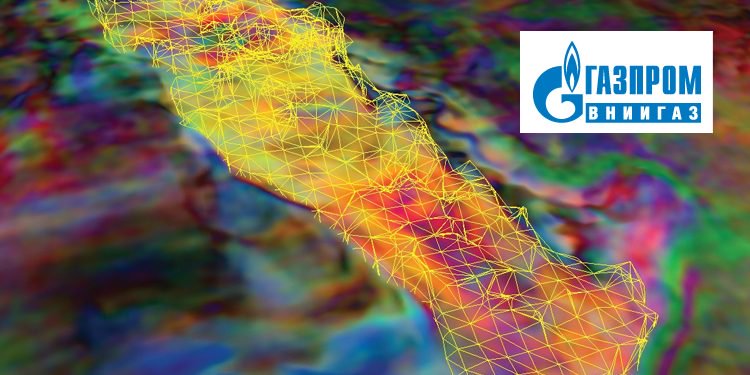Prediction of Oil and Gas Presence in Jurassic-Cretaceous Sediments within the Area of Ob and Taz Gulfs at Kara Sea
After the successful exploration of the gas accumulations in the Cenomanian stage at the fields of the Ob and Taz Bays, the real task now is to further explore the subadjacent deposits and discover any new hydrocarbon accumulations in the Lower Cretaceous and Jurassic deposits. The analysis of the geologic and geophysical information, obtained as a result of the well’s drilled at all the discovered fields in the area and the many adjacent onshore wells, provides this possibility. The available reliable structural imaging of the major reflecting interfaces of the sedimentary cover (Г, М1 and Б) made it possible to update the structural and tectonic picture of the whole Ob Bay and Taz Bay area. As it proved to be, all the structures discovered here, and the HC fields related to them are associated with a well-defined structural low. The analysis of the conditions for oil-and-gas bearing capacity of the Jurassic-Lower Cretaceous deposits at the discovered gas fields of Kamennomysskoye, Semakovskoye and Obskoy, as well as the gas-condensate fields of Severo-Kamennomysskoye and Tchugoryakhinskoye, taking into account the tectonic structure and oil-and-gas bearing capacity of the Karsko-Yamalo-Gydanskaya and Nadym-Pur-Tazovskaya syneclise make it possible to conclude a high probability of discovering new HC accumulations here. Prerequisites for such predictions are the following: favorable structural and tectonic conditions (conjunction zone of solid Nurminsky and Nizhne-Messoyakhsky megaswells, surrounded by parts of rift-valley downfolds- Soyakhinskoye in the North, and Parusovoye – in the South); presence, in the cross-section of the sedimentary cover, of natural reservoirs of regional, zonal and local spread, combined with powerful cauldrons of HC generation, As well as probable degasation of hydrogene from the subsoil, which contributes to hydrogenation of organic matter and synthesis of HC. The high probability of oil-and-gas bearing capacity of the Jurassic and Lower-Cretaceous deposits has been also determined in the context of the identified specific structure features of the discovered fields and their discovered structures, and namely, their dimensions and magnitude increasing with the depth, as well as probable offset of domes relative to explored HC deposits in the Cenomanian and Apt-Albian deposits. Some new solid HC occurences of the Jurassic and Lower-Cretaceous deposits are expected at the fields of Kamennomysskoye Sea, Severo-Kamennomysskoye, Tchugoryanskoye and Semakovskoye. More solid occurences of HC, compared with the Cenomanian occurrence of HC, are predicted in the deposits of Jurrasic period at the Obskoye field.
After the successful exploration of gas accumulations in the Cenomanian deposits of the Ob Bay and Taz Bay at the fields of Kamennomysskoye Sea, Severo-Kamennomysskoye, Tchugoryakhinskoye, Obskoye, Semakovskoye, Tota-Yakhinskoye and Antipayutinskoye, the main task is to additionally explore the gas-condensate occurencies, discovered lower, and discover new hydrocarbon (HC) occurrences – gas-condensate-, oil and gas-codensate- and probably oil fields in the Lower Cretaceous and Jurassic deposits. The analysis of geologic and geophysical information, obtained as a result of the wells drilled at all of the discovered fields within the area and many adjacent onshore fields, provides such a possibility. The fields with deposits of the mentioned fluid content, unambiguously confirming the commercial productivity of the Jurassic and Lower Cretaceous deposits in the area of the Ob Bay and Taz Bay of the Kara Sea, are listed in Table 1.
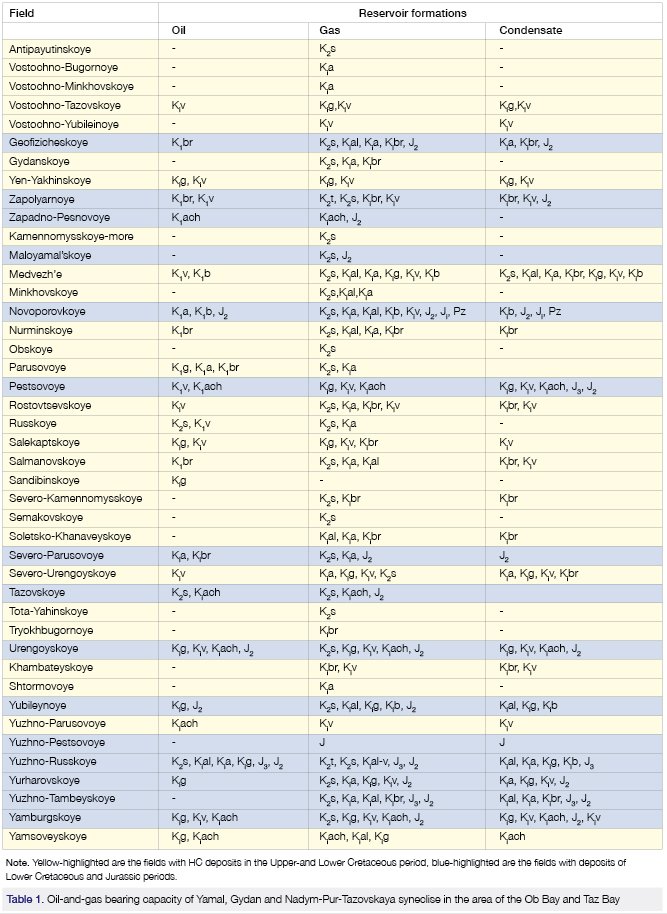
The HC occurences have been discovered in the deposit of Jurassic period at 15 out of 37 fields having HC deposits, not only in the Cenomanian complex of the Upper-Cretaceous deposits, but in the lower reservoirs of the Lower Cretaceous and Jurassic period. HC accumulations were discovered in the Jurassic and Lower-Cretaceous HC deposits, in the structures of Novoportovskaya, Bovanenkovskaya, Kharasaveiskaya, Malyshevskaya,
Severo-Tambeyskaya; In the Kara Sea – at Universitetskaya; the Gydansky Peninsula – at Geofizicheskaya, Utrennyaya, Minkhovskaya, Gydanskaya; Southward of the Taz Bay- at Yamburgskaya, Urengoyskaya, Severo-Urengoyskaya, Medvezhya and others. Also, one should take into account that the deposits of the Jurassic complex were discovered by drilling at less than half of the fields and structures that were actually drilled.
The available reliable structural imaging based on the detailed seismic survey data of various periods, as well as of drilling, related to the reflecting horizons of the sedimentary cover, made it possible to update the structural and tectonic picture of the Ob Bay and Taz Bay as a whole. The conjunction zone of the bays is in such an anticline zone in the area of the Nurminsky and Nizhne-messoyakhsky megaswell conjuction. As it proved to be, all the structures, and the HC fields related to them, are associated with a well-defined anticline (it could be named Kamennomysskaya-Tchugoryakhinskaya, by the names of the structures located there) between the south-eastern periclinal of Nurminsky megaswell, which crosses the southern part of the Yamal peninsula, and the western pericline of a similar solid Nizhnemessoyakhsky megaswell (Messoyakhsky threshold) in the northward conjunction with the Nadym-Pur-Tazovskaya syneclise.[1-3]
The Nizhnemessoyakhsky megaswell with its northern slopes, in its turn, is bordering with Soyakhinsky and Antipayutinsky the northen rift-valley downfolds, which separate Gydansky dome and Tanamsky megaswell. (Fig.1) The southern wing of the anticline, judging by all the reflecting horizons of the sedimentary cover, links with the vast Parusovy downfold, and to the east – with Severo-Yambugsky downfold.

Soyakinsky and Parusovy downfolds have the type of rift-valley downfolds and are elements of the unified rift-valley downfold system of the West-Siberian petroleum basin. Thick source rock intervals have been accumulated at such downfolds, containing organic matter of sapropelic, humic, and mixed type, as well as multiple coal layers [4, 5]. Such mix of organic matter generated bath gaseous and liquid HC [2, 6]. Being sunken at optimal depths with certain temperatures and pressures, such thicknesses form powerful sources of HC generation – major zones of generation of gas, oil and gas, as well as deep-earth gas. A further positive role in this process is played by increased thermal flux and ingress of deep-earth hydrogene through the faults of the rift-valley downfold system. The deep-earth hydrogene, while hydrating petrologen, accelerated the synthesis of HC and contributed to embrittlement of the earth material, creating additional volumetric space for lateral and vertical migration of HC and formation of various fluid content [1, 2] The most favourable conditions for shaping of deposits were created within the inter-rift-valley-downfold, inter-fault, and near-fault hypsymethrically upstanding blocks of syndepositional type, as well as inversion blocks, in sedimentary cover of which, as well as in the rocks of transient formations and basal complex, the most solid traprocks were formed up. This way the shaping of HC deposits at the solid Novoportovsky swell was taking place, as well as at other structures of Nurminsky megaswell, and also similar structures of the whole north of the West Siberia.
Additional structural imaging, based on the integrated data of seismic survey and drilling, made it possible to update the structural plans of reflecting horizons, Г – at the roof of the rocks of Cenomanian stage, M1 – at the roof of the rocks of Aptian stage, and Б – at the roof of the rocks of the Upper Jurassic period (Bezhenov Suite). According to the data of updated imaging, the known gas occurencies in the terrigenous reservoirs of the Cenomanian deposits are associated with the structures, grouping into two isolated swells: 1) Kamennosmyssko-Tchugoryakhinsky swell, with en echelon-like position of the structures of Kamennomysskaya, Severo-Kamenomysskaya and Tchugoryanskaya – in the western part of the anticline; 2) Obsko-Semakovsky swell, assembling the structures of Obskaya, Parusovaya, Severo-Parusovaya and Semakovsksya (Fig.2). Thus, there exist favorable structural and tectonic conditions for formation of sufficiently solid zone of oil and gas accumulation, surrounded from the north and south with hypocenters of HC generation cauldrons, provided some subjacent structural closures are available there, contributing to local accumulation of HC.
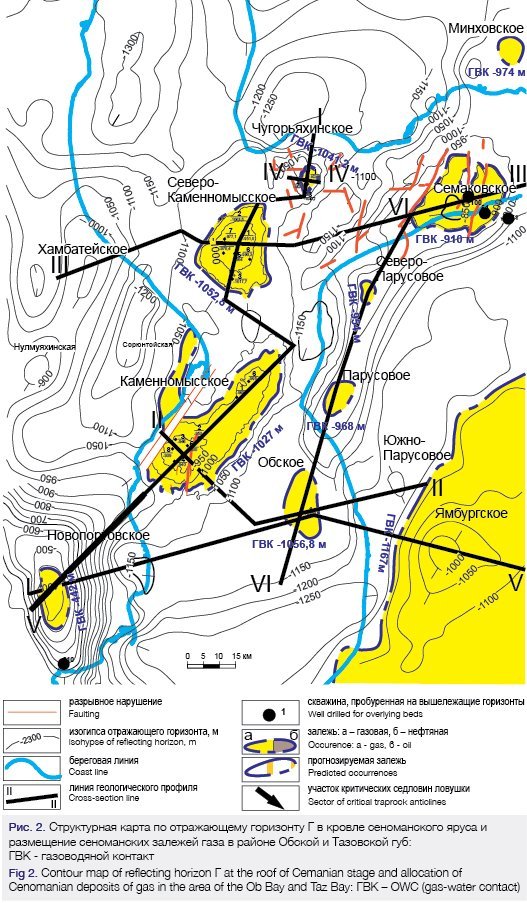
The general submission, it is compelling to continue the analysis and generalization of geologic and geophysical data on Neokom-Aptian and Jurassic complexes of the sedimentary cover is non-optimality of position and/or insufficient in depth of the single drilled wells to the Sub-Cenomanian deposits, not letting an unambiguous conclusion regarding the commercial oil-and-gas bearing capacity of these deposits. Thus, deep well #6 of Kamennomysskoye Sea field, drilled at the northern pericline of the structure, seemed to have opened the gas-condensate occurence in the Achian Suite, in formations БЯ14-16 Такs, but the following well #8, practically drilled in the dome of the major part of the structure, was stopped in the same Achian Suite, and did not open optimal part of the wedgeouts, as well as the below positioned dome which is part of the Jurassic complex, where the gas-condensate and possibly oil-and-gas condensate deposits have been predicted. (Fig.3, see Fig.2), Like Novoportovskoye and the other neighbouring fields. The depth of Well 8 must have reached at least 4200 m before opening, all the way through the thickness, of deposits of the Middle Jurassic (reservoirs ЮТ2…ЮТ5 of Malyshev Suite and ЮТ7…ЮТ9 of Vymskaya Suite, are predicted here, bounded with argillous impermeable seams) and Lower Jurassic (reservoirs ЮТ10…ЮТ17 of Nadoyakhin (Dzhangodi formation) Suite, as well as ЮТ18.. .ЮТ23 of Zimnyaya Suite). Besides, Ahskaya Suite, with the clinoform geology within the structure, needs additional exploration of its wing parts, where gas-condensate deposits may be present, like the cross-section of well 6 at the northern pericline of the structure (Fig.5-6).

The gas-condensate deposit was discovered by wells 5-7 of Severo-Kamennomysskoye field, practically drilled at the dome of the structure in the deposits of the Hauterivian stage (in the lower part of Tanopchinskaya Suite – formation ТП26). However, the lower deposited formations of Neokomian and Jurassic stages were not explored by drilling (see Fig.3). Based on the drilling results, the structural and lithologic-and-facies conditions for accumulation of HC deposits in the Neokomian and Jurassic deposits, not opened by drilling are similar, or even better than they are at the Kamennomysskoye Sea field, therefore the association of the predicted HC deposits in the interval of Neokomian and Jurassic Suites could be similar to the Kamenomysskoe Sea field.

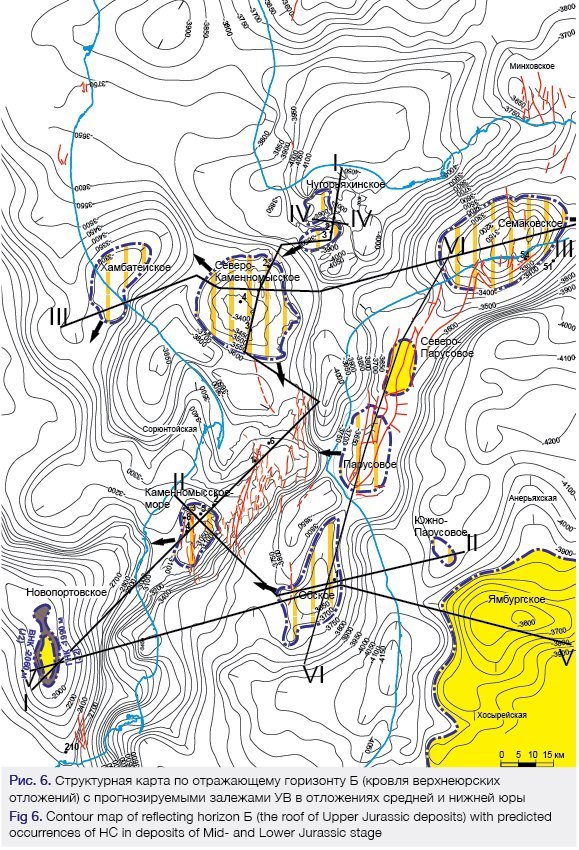

HC occurrences in the Jurassic-Neokomian deposits, are not opened by drilling, are probable at the seaside of Semakovskoye field. The wells drilled at this field, which opened the deposits of Neokomian and Mid-Jurassic period, have been located in the land (southern) part of this structure, and quite possible, for the structural conditions of the lower part of the cross-section they proved to be in the wrong place (Fig.7). Besides, they opened just the upper, smaller, part of the Mid-Jurassic formation. Here, the formations of БУ group have thickness of 8 to 52m, where net thickness range from 2 to 12m. According to the interpreted data of geophysical survey, formations БУ6 and БУ8 were substracted at well 54, with unclear type of saturation in the depths of 2843 to 2920m. Non-commercial influx of gas with flow rate of 3,6 thous.m3/d and condensate with that of 0,01 m3/d was received during the formation testing at well 51, at the depths of 2071 to 3088m. Undiscovered HC occurrences have been predicted at Semakovskoye field, both in the Neokomian, and in Jurassic, including Lower Jurassic part, complexes of deposits. (see Fig 5-7).
Such prediction is confirmed with the facts of HC deposits discovered in the formation of Neokom and Jurassic at the fields considerably smaller than Semakovskoye,–namely, Severo-Parusovoye, Parusovoye and Yuzhno-Parusovoye, associated with the Aderpatinsky swell and constituting, together with Semakovskoye field, integrated zone of gas-oil accumulation. We should note that the deposits of Jurassic complex, at Yuzhno-Parusovoye and Parusovoye fields, were not explored by drilling under optimal structural conditions.
Not explored deposits of Berriass-Hauterivian (Ahskaya Suite) and Jurassic period of Tchugoryahinskoye field. In the northern part of the gas-condensate occurrence in formation ТП23 reserves have been calculated by category C2 The lower part of the cross-section of sedimentary cover of the field was not explored by drilling. According to the data of 2D seismic survey, in the closed contour of minus 2940m of the roof of Neokomian complex (reflecting horizon B0 ) the area of the structure makes up 92,7km2, which is considerably higher than the areas of traprocks along the above deposited formations of Barremian, Apt-albian and Cenomanian occurencies. Besides, the magnitude of the structure increases for the Neokomian complex up to 110m, with almost ideal coincidence of the crests of the reservoir traprocks. . However, the integrated Tchugoryakhinskaya structure, across the reflecting horizon Б at the roof of Bezhenov Suite of the Upper Jurassic, falls into two structures, located in the southern and northern marginal reservoir areas of the above positioned traprocks in the overlying sediments of Cretaceous period (see Fig.6), which considerably complicates the structure of the lower part of the sedimentary cover of the Tchugoryakhinskoye field. The closed contours of the southern traprock have elevation of minus 3840m, those of the northern one –re minus 3910m, their magnitudes are 25m and 35m, correspondingly. The areas of these structures within the boundaries of lower closed contours make up 13,60km2 and 28,65km2, correspondingly. Some complex relationship can be also seen between the structure plans of the Jurassic deposits, with underlying bedrocks, apparently, trias and primary rock. Alongside with that, the HC traprocks in the reservoirs of Neokomian and Jurassic complexes can be commercially oil-and-gas bearing and contain considerable reserves of gas, condensate and oil of industrial grade.
Due to the fact that the Tchugoryakhinskaya, Severo-Kamennomysskaya, KamennomysskayaSea, Obskaya and other structures of the examined region were positioned at the Berrias-Hauterivian times near the south-western source areas of terrigenous material, the presence is quite possible of good reservoirs within the whole stratigraphic range of development of sandy and clayrock member in the Ahskaya Suite. Based on the results of the regional seismic surveys run in the offshore area of the Ob Bay, in the seismic tomography velocity cross-section 11, one can see anomalous zones of the velocity drops, by 10 to 20%, at the survey marks of of
50…75 km between horizons M1 and Б, in the interval of depths 2000…2800 m (N.M.Ivanova, Yu.V.Roslov and others, FGU NPP “Sevmorgeo”, 2008), which is apparently related to existence in the cross-section of some rocks featured with good reservoir properties, and probable existence of HC deposits there. According to the same materials, the areas of development of clinoform deposits of Neokomian period are well delineated in the cross-sections of the seismic characteristic “the instantaneous phase”.
The data analysis of oil-and-gas bearing capacity of the already discovered deposits of the fields of the Ob Bay and the Taz Bay make it possible to predict discovery of gas and gas-condensate occurrences at the Tchugoryakhinskoye gas-condensate field, beside the Cenomanian, Barremian (formations ТП20, ТП22) and Hauterive-Valanzhian (formation ТП23) deposits, as well as probable oil-and-gas bearing capacity of formations ТП24-25, ТП26, БЯ10, БЯ11-12, which are productive at the neighboring fields and located in similar lithologic-and-facies conditions, matching the Yamal type of the Neokomian cross-section. According to the correlation analysis of areas with productivity of Barremian and Hauterivian-Valanzhian deposits, all the mentioned formations are steadily tracked up to the Tchugoryakhinskoye field. As a rule, they are crossed with members of argillaceous deposits which can be firm impermeable seams. are reliable.
The quantitative evaluation of predicted recoverable reserves of gas, condensate and oil in the Neokomian and Jurassic complexes of sedimental cover of the Tchugoryakhinskoye field was carried out with account of average mean specific density of recoverable HC reserves in the mentioned complexes at the nearest fields, more explored by drilling. Calculations show it that, in case of 100% filled HC traprocks, the Neokomian complex of deposits may contain 76,93MM tons of reference fuel, including 35,20bcm of gas, 3,07MM tons of condensate and 38,66MMt of oil (see Table 2). It is predicted that 65,43MMt of reference fuel of recoverable reserves, including 46,55bcm of gas, 4,21MMt of condensate and 14,67MMt of oil can be contained in the deposits of Jurassic complex in the two mapped domes.
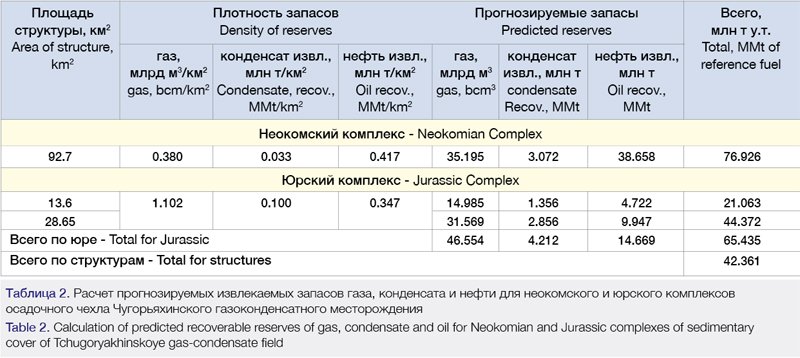
Gas reserves contained in the southern dome may make up 14,98bcm of gas, 1,37MMt of condensate, 4,72 MMt of oil, and 21,06MMt of reference fuel. For the northern dome, the values of recoverable reserves of gas, condensate and oil, may amount to 31,57bcm, 2,86 и 9,95 млн т могут составить соот¬ветственно 31,57 млрд м3, 2,86 and 9,95MMt, correspondingly, in the total amount of 44,37MMt of reference fuel. As a whole, one predicts the HC reserves in the Neokomian and Jurassic oil-and-gas bearing complexes in amount of ca. 142,36MMt of reference fuel, which can present a commercial interest in the area with the existing and newly created gas-and-oil fields. Judging by the Hauterivian-Valanzhinian deposits the spacing factor for traprocks in the zones of interest could be accepted equal to 0,81, similar to the occurrence of formation ТП26 of the Severo-Kamennomysskoye field. Further supplementary exploration of the field can be related to verification of predicted oil-and-gas bearing capacity of the Jurassic complex of deposits in the southern dome, and in case of confirmed commercial oil-and-gas bearing capacity of the Jurassic complex of deposits at the southern dome, drilling of prospect-evaluation well is possible at the northern dome. The depth of the prospect-evaluation well at the southern dome of the structure should be 4400m, and that one at the northern dome – 4500 m. At that, the well at thee southern dome would make it possible to obtain data about the structure, petrophysical properties and oil-and-gas bearing capacity of the southern parts of the occurences in the depoits of the Neokomian period, which would make it possible to update the knowledge of their reserves and optimize the position of development wells at the Neokomian deposits. At the Obskoye field, with a small occurrence of gas in formation ПК1 of Cenomanian deposits, where the deposits of Barremian stage were discovered by well 1, one should not exclude the gas-condensate, and possibly, oil occurrences in the lower part of the Tanopchinskaya Suite of the Barremian stage, in the Ahskaya Suite of the Neokomian stage, as well as in the deposits of the Jurassic complex (Fig.8, see Fig.6,7). The Obskays structure, in the deposits of Jurassic complex, has more solid dimensions and magnitude, in difference from the Cenomanian one, which, taking into account the availability of commercially significant deposits of hydrocarbons in the deposits of the Lower Cretaceous and Jurassic period at the nearest fields of Parusovoye, Severo-Parusovoye and other fields of the Tazovsky, Yamalsky and Gydansky peninsulas, makes it more attractive in terms of continued prospecting works, targeting the predicted occurences of hydrocarbons in the deposits of Lower Cretaceous and Jurassic periods.
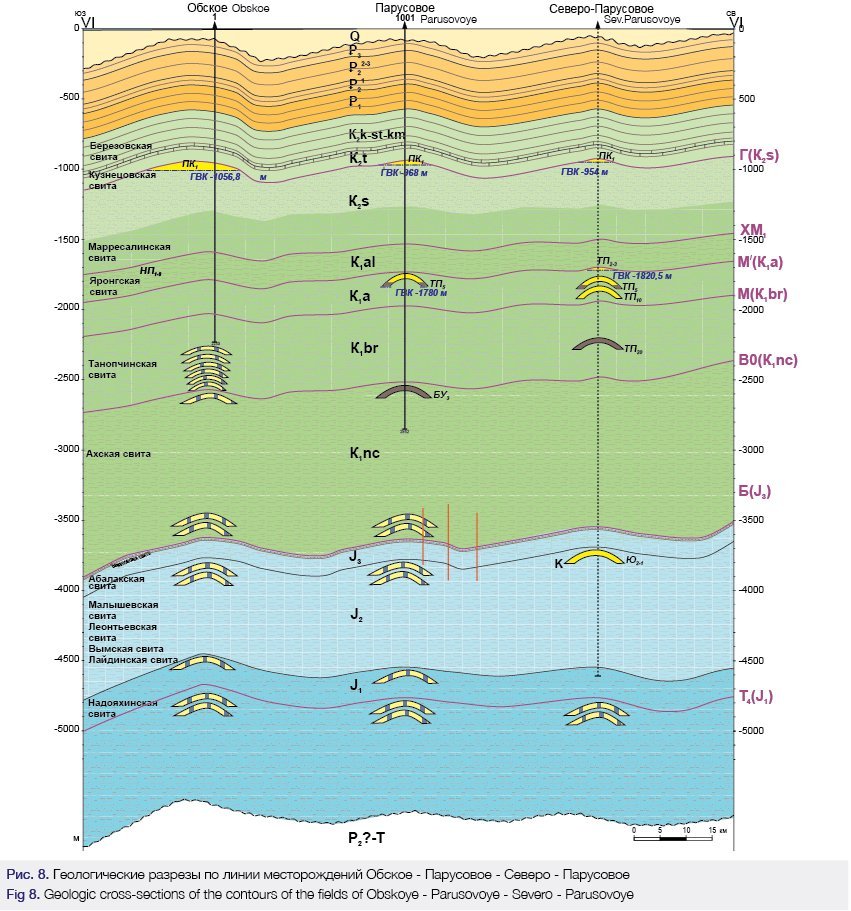
The availability of mutually agreed longitudinal sections across the fields of the Ob Bay and Taz Bay and their comparison with the fields of adjacent dry land, where multiple occurrences of hydrocarbons were discovered not only in the Low Cretaceous but in the Mid- and Lower Jurassic deposits, makes it possible to verify that new occurrences of HC in the Lower Cretaceous and Jurassic oil-and-gas bearing complexes are probable at practically all the fields discovered in this area. Changes made to the structure plan of deposits of the Jurassic complex, with the use of 2D and 3D materials of seismic survey, combined with drilling data, make it possible to project the increment in dimentions and extension of the eastern part of the Khambateyskaya structure towards the offshore area of the Ob Bay. Due to this, one predicts undiscovered HC occurrences both at the lower part of the Neokomian, and in the known reservoirs of the Mid- and Lower Jurassic stage (see Fig.6,7) Here it is expidient to carry out detailed seismic survey activities with the purpose to specify the dimensions and morphology of the Neokomian and Jurassic traprocks, expected fluid content and resources of predicted HC occurences, with further decisions regarding the advisability of drilling works.
Therefore, the analysis of structural and tectonic conditions of the oil-and-gas bearing capacities of the Jurassic-Lower Cretaceous deposits and the spread of the known commercially gas-and-oil saturated formations in the sedimentary cover, and predicted formations at discovered gas fields of Kamennomysskoye, Semakovskoye and Obskoye, and gas-condensate fields of Severo-Kamennomysskoye and Tchugoryakhinskoye, with account of tectonic structure and oil-and-gas bearing capacity of Karsko-Yamalo-Gydanskaya and Nadym-Pur-Tazovskaya syneclises, makes it possible to draw a conclusion about the high probability of discovering new occurences of HC deposits. Prerequisites for such prediction are: favorable structural and tectonic conditions (determined anticline-type zone, named Kamennomyssko-Tchugoryakhinskaya zone, of conjunction of solid Nurminsky and Nizhne-Messoyakhsky megaswells, surrounded by parts of rift-valley downfolds- Soyakhinskoye in the North, and Parusovoye – in the South); presence, in the cross-section of the sedimentary cover, of natural reservoirs of regional, zonal and local spread, combined with powerful cauldrons of HC generation, As well as probable hydrogene degasation of subsoil, which contributes to hydrogenation of organic matter and synthesis of HC.
The high prospectivity of oil-and-gas bearing capacity of the Jurassic and Lower-Cretaceous deposits has been also determined in the context of identified specific structure features of the discovered fields and their discovered structures, and namely, their dimensions and magnitude increasing with the depth, as well as probable offset of domes relative to explored HC deposits in the Cenomanian and Apt-Albian accumulations. The account of these peculiarities of the structure makes it possible to spread the scopes of 3D seismic survey works and allot the prospecting and exploration wells when drilling the Lower Cretaceous and Jurassic traprocks both at discovered fields and at new sites, for example, at an extension of the Khambateyskaya structure.
New solid occurrences of hydrocarbons in the Jurassic-Lower Cretaceous deposits may be discovered at the fields of Kamennomysskoye Sea, Severo-Kamennomysskoye, Tchugoryakhinskoye and Semakovskoye. More solid occurrences, compared to discovered Cenomanian gas occurrence, are predicted in the deposits of the Jurassic period at the Obskoye field. At that, it is necessary to take into account rather complicated structure of deposits of the Jurassic complex [7], which may be featured with lithologic, stratigraphic, tectonic screens and can be associated with separate members of structures – the wings, periclines, as well as inter-structural shallows, structural noses and terraces.
References
1. ASTAFYEV, D.A., V.F. SKOROBOGATOV, A.M. RADCHIKOVA. Structural-geodynamical features of constitution and location of oil-gas-accumulation zones at north of Western Siberia [Strukturnogeodinamicheskiye osobennosti stroyeniya i razmeshcheniya zon neftegazonakopleniya na severe Zapadnoy Sibiri]. Proc. of the VII International sci.-practical conference “New ideas in Earth sciences”. Moscow: Russian State Geological Prospecting University n.a. Sergo Ordzhonikidzе, 2005, pp. 168. (Russ.).
2. ASTAFYEV, D.A., V.F. SKOROBOGATOV, A.M. RADCHIKOVA. A graben-rift system and location of oil-gas-accumulation zones at north of Western Siberia [Graben-riftovaya sistema i razmeshcheniya zon neftegazonakopleniya na severe Zapadnoy Sibiri]. Geologiya Nefti i Gaza. 2008, no. 4, pp. 2–9. ISSN 0016-7894.(Russ.).
3. KHARAKHINOV, V.V., N.M. KULISHKIN, S.I. SHLENKIN. Mesoyakha rise as a unique oil-gas-geological object at the north of Siberia [Messoyakhskiy porog – unikalnyy neftegazogeologicheskiy obyekt na severe Sibiri]. Geologiya Nefti i Gaza. 2013, no. 5, pp. 34–48. ISSN 0016-7894. (Russ.).
4. YERMAKOV, V.I., V.A. SKOROBOGATOV. On proportions of gas and oil in the Jurassic and Cretaceous sediments at the north of Western Siberia [O sootnoshenii gaza i nefti v yurskikh i melovykh otlozheniyakh na severe Zapadnoy Sibiri]. In: Collected papers of IGiRGI. Moscow: Institute for Geology and Mining of Fossil Fuels, 1982, pp. 18–29. (Russ.).
5. SKOROBOGATOV, V.A., L.V. STROGANOV, V.D. KOPEYEV. Geological structure and oil-gas-bearing capacity of Yamal [Geologicheskoye stroyeniye i neftegazonosnost Yamala]. Moscow: Nedra-Biznestsentr, 2003. (Russ.).
6. PLOTNIKOV, A.A., V.Ye. KICHENKO. Jurassic series as a new promising course in search of oil deposits under gas cap in Arctic regions of Western Siberia [Jurskiy kompleks – novoye perspektivnoye napravleniye poiska neftyanykh podgazovykh zalezhey v arkticheskikh rayonakh Zapadnoy Sibiri]. Proc. of the 1st Int. conf. “Arctic Region Oil & Gas (AGOR 2007). Moscow: Interkontakt Nauka, 2007, pp. 117–125. (Russ.).
7. ASTAFYEV, D.A., G.R. PYATNITSKAYA, A.M. RADCHIKOVA et al. Jurassic productive series as the most important object for search and prospecting of hydrocarbon agglomerations in Nadym-Pur-Taz region till 2030 [Yurskiy produktivnyy kompleks – vazhneyshiy obyekt poiskov i razvedki skopleniy uglevodorodov v Nadym-Pur_Tazovskom regione do 2030 goda]. International Conference «World Gas Resources and Reserves and Advanced Development Technologies» (WGRR-2007): abstract of papers. Moscow: Gazprom VNIIGAZ, 2007, pp. 79–80. (Russ.).
Author
Astafyev, D.A., A.V. Tolstikov, M.A. Kalita, L.A. Naumova, M.Yu. Kabalin
Gazprom VNIIGAZ LLC, Russian Federation, 142717, Moscow region, Leninsky district, Vilkovskoye rural settlement, Razvilka housing complex, Proektiruyemy passage # 5537, Estate 15, Bldg. 1
The original article was first published in the «Vesti Gazovoy Nauki» scientific journal no. 3, 2018.
Published with thanks to the Gazprom VNIIGAZ LLC.

